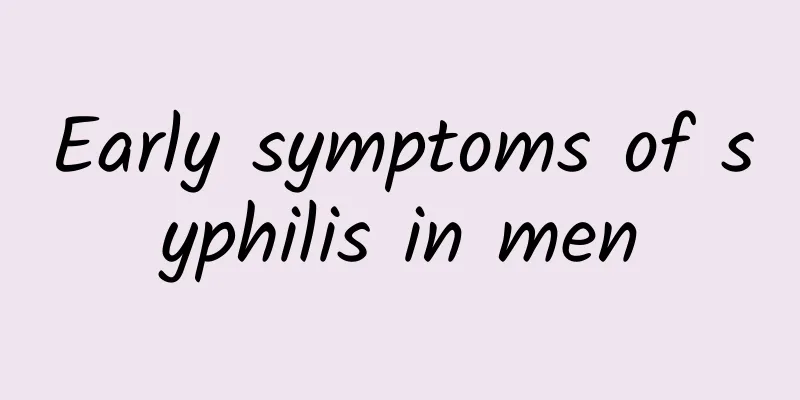What to do if your testicles are damaged

|
The testicles are an important part of the male body. Although the testicles are highly mobile, they are also fragile and have a particularly low resistance to damage. Even a slight external impact will affect the health of the testicles. The most obvious symptom is severe pain, including pain in the abdomen. Once the testicles are injured, medical treatment should be sought promptly. Only in this way can the health of the testicles be better guaranteed. Causes 1. Trauma Gunshot injuries often involve multiple combined injuries. When a shrapnel injury is sustained, the testicle may be partially, mostly, or completely missing. Because the testicle is highly mobile, direct puncture injury and testicle damage are less likely. 2. Frustration Caused by kicking, falling or being ridden. Clinical manifestations 1. Local severe pain, the pain may radiate to the lower abdomen, waist or upper abdomen, and may even cause painful shock. The pain may also be accompanied by nausea and vomiting. 2. Examination shows scrotal swelling, bruises and congestion of the skin, and enlarged and hard testicles on the affected side with obvious tenderness. Often accompanied by scrotal hematoma, hydrocele or hemocele, etc. In the later stage of testicular ischemia and atrophy, the testicles are small and soft. 3. When the testicle ruptures, the testicular boundary cannot be clearly felt; when the testicle is dislocated, the scrotum is empty, and a testicular-like swelling is often felt in the lower abdomen and perineum; when the testicle is torsionally rotated, the testicle is elevated and becomes horizontal or the epididymis is located in front of the testicle, the spermatic cord becomes thicker, and the pain does not decrease or may even increase when the scrotum and testicle are lifted. Check B-ultrasound and Doppler examinations are valuable in determining testicular rupture and reduced testicular blood supply. When the testicle is ruptured, a hypoechoic area may appear; when the testicle is torsion, reduced testicular blood perfusion may occur on the injured side. If a clear diagnosis cannot be made, surgical exploration may be performed. Diagnosis After scrotal injury, due to clinical manifestations such as scrotal swelling, pain and bruises, diagnosis is not difficult. The important thing is to determine whether the testicles are injured. If it is misdiagnosed, it often leads to hematoma, followed by infection or testicular compression and ischemia, and finally testicular atrophy, affecting the patient's sexual function and fertility. Differential diagnosis 1. Acute epididymitis and orchitis There are also symptoms such as testicular pain and scrotal swelling. Examination of the testicles and epididymis shows enlargement, hardness, and obvious tenderness. However, this disease is more common in adults, with a slow onset. Although the scrotum is swollen, there are no changes such as cyanosis and congestion of the skin. There is often a history of using instruments in the urethra and indwelling catheterization, accompanied by systemic symptoms such as chills and fever. Routine blood tests show a significant increase in the number of neutrophils. 2. Incarcerated indirect hernia In case of incarcerated inguinal oblique hernia, there may be severe pain in the scrotum, and the pain is obvious. However, this disease generally has a history of reducible scrotal or groin swelling, and has symptoms such as abdominal distension, nausea, vomiting, and no anal gas and defecation. Examination of the abdomen shows hyperactive bowel sounds, with a sound of gas passing through water, and an oval swelling in the scrotum can be palpated. The testicles are normal and tender, and the pain symptoms do not change when moving. 3. Testicular tumor The testicles are progressively enlarged and hard, but there is no history of trauma. The mass feels heavy and inelastic, and there is no obvious tenderness. Tests for tumor markers such as AFP alpha-fetoprotein and HCG human chorionic gonadotropin can sometimes be positive. Retroperitoneal lymph node CT or lymphangiography can sometimes reveal enlarged lymph nodes infiltrated by cancer. If necessary, surgical exploration and biopsy can be performed to detect tumor cells. treatment 1. Debridement and suture For open testicular injury, the wound should be thoroughly cleaned, foreign bodies should be removed, inactive testicular tissue should be cut off, and the testicular tunica albuginea should be sutured after hemostasis. For patients with combined spermatic artery injury, if the testicular injury is not serious, it can be retained and repaired with microsurgery. For patients with severe testicular swelling, the tunica albuginea should be incised and relieved before suturing to avoid excessive pressure on the testicular tissue and testicular atrophy. A rubber drainage should also be placed in the scrotum to prevent scrotal hematoma and infection. 2. Orchiectomy The only indication for orchiectomy is when the blood supply to the testicle is completely stopped. In cases where the testicle is severely damaged or the testicle tissue is completely damaged and orchiectomy is necessary, efforts should be made to preserve part of the testicular tunica albuginea, because there are many androgen-secreting cells close to the inner surface of the tunica albuginea. For testicular torsion, if the testicle is already necrotic, orchiectomy is performed. 3. Non-surgical treatment Patients with testicular injury and shock should receive active anti-shock treatment, analgesia, hemostasis and anti-infection treatment. Patients with stable conditions should rest in bed, elevate the scrotum, and apply local cold compresses to relieve pain and promote wound healing. For early testicular dislocation, manual reduction can be tried. If edema is obvious and manual reduction is difficult to succeed, open surgery should be performed as soon as possible to reduce and fix the testicle. For testicular torsion, surgical reduction should be performed within a few hours, and the testicle should be fixed to the bottom of the scrotum to avoid testicular atrophy or necrosis and prevent torsion from occurring again. |
<<: Prostatitis injection therapy
>>: Does obesity affect penis length?
Recommend
Why is a man's sperm yellow?
Under normal circumstances, normal male semen is ...
What medicine is good for scrotal dampness?
The troublesome thing about scrotal eczema is tha...
Will I get pregnant if I don't wear a condom for the first time?
For many men and women who are experiencing the f...
Introduction to sperm maturation
Men produce sperm every day, so many people may w...
There is a red mark on the glans penis, but it does not hurt or itch.
Although men are born with good physical fitness,...
What foods can make men gain weight? Be aware of the high-calorie trap!
For those who want to control their body shape, t...
Can the root of agarwood be eaten? Eating agarwood root like this can remove dampness
Amaranthus is the most common wild vegetable in o...
Will eating amaranth turn your urine red? Eating it regularly can clear away heat and detoxify
Amaranthus is a favorite wild vegetable in summer...
Four kinds of food are the best for kidney health! Be a pure grandfather
As an excellent man in the new era, how can you l...
Why does my husband urinate frequently?
I believe that many married women will find that ...
The dangers of cystitis in men
Cystitis is a disease that harms the bladder. It ...
How to treat sweaty hands and feet? Paying attention to conditioning is the key
If only your hands and feet are sweating, it is a...
Learn about the father of IVF
Many people should know about test tube babies. T...
How to Increase Testosterone Levels
Testosterone levels are an important health indic...
Why does it hurt when a man ejaculates?
Men reach climax when they ejaculate. This feelin...









